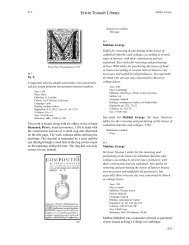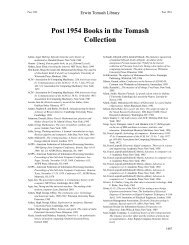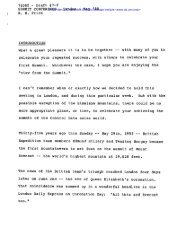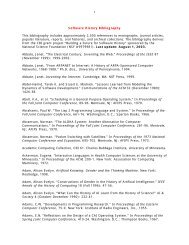B chapter.indd - Charles Babbage Institute - University of Minnesota
B chapter.indd - Charles Babbage Institute - University of Minnesota
B chapter.indd - Charles Babbage Institute - University of Minnesota
Create successful ePaper yourself
Turn your PDF publications into a flip-book with our unique Google optimized e-Paper software.
140<br />
Edition: 1st (German)<br />
Language: German<br />
Binding: later vellum over boards<br />
Pagination: pp. [12], 68, 192, [38]<br />
Collation: )( 4 )()( 2 2A–2H 4 2I 2 A–2A 4 2A–2D 4 2E 3<br />
Size: 196x155 mm<br />
Reference: Pogg Vol. I, p. 183<br />
Johann Beyer was not only a well-known Frankfurt<br />
physician and mathematician but was also a person <strong>of</strong><br />
civic eminence due to his position as Bürgermeister. His<br />
wide contact with the scientific community is illustrated<br />
by a letter he is known to have written to Kepler in 1616<br />
in which he used a combination <strong>of</strong> both the decimal<br />
point (actually a comma) and the old system <strong>of</strong> accents<br />
to represent decimal fractions. For example, Beyer wrote<br />
the number 314.15926 (100π) as 314,1’5’’9’’’2’’’’6’’’’’<br />
(using a comma as the decimal indicator but still using<br />
the accents as well) and claimed this system <strong>of</strong> notation<br />
as his invention. This may well have been true as far as<br />
Beyer was concerned; however, Simon Stevin had used<br />
the decimal point notation years earlier. The same system<br />
<strong>of</strong> notation, this time with multiple and inconsistent uses<br />
<strong>of</strong> the decimal point and Roman numerals for the accents,<br />
can be seen in this work.<br />
Erwin Tomash Library<br />
Beyer, Johann Hartmann Beyer, Johann Hartmann<br />
B 148<br />
Accents denoting decimal places, B 148<br />
This book is an early basic work on gauging, with<br />
emphasis on the calculation <strong>of</strong> the volume contained in<br />
various solid geometric figures. Beyer also discusses<br />
the extraction <strong>of</strong> cube roots, gives practical examples<br />
<strong>of</strong> gauging and includes tables for such things as the<br />
circumference and area <strong>of</strong> circles having diameters from<br />
0.1 to 108 units in steps <strong>of</strong> 0.1 unit. Unfortunately, the<br />
value <strong>of</strong> π Beyer used appears to be 3.14172 rather than<br />
3.14159, and this value limits their usefulness (accurate<br />
values for π had been calculated to 35 decimal places<br />
prior to the date <strong>of</strong> this publication).<br />
Illustrations available:<br />
Title page<br />
Decimal point example<br />
Table page<br />
B 149<br />
Beyer, Johann Hartmann (1563–1625)<br />
B 149<br />
Stereometriae inanium nova et facilis ratio, geometricis<br />
demonstrationibus confirmata & necessariis<br />
obscuriorum quorundam delineationibus illustrata:<br />
Qua corporum regularium omnium, tam rectilineorum<br />
quam curvilineorum capacitates promtissime<br />
explorantur.<br />
Year: 1603<br />
Place: Frankfurt<br />
Publisher: Zacharias Palthenius for Jonas Rhodius<br />
Edition: 1st (Latin)<br />
Language: Latin<br />
Figures: 67 woodcut text diagrams, numerous charts<br />
Binding: contemporary vellum over boards







